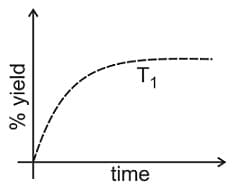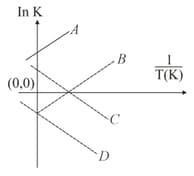The change in standard Gibbs energy for a reaction at equilibrium, e.g.,, on addition of an inert gas at constant pressure and then at constant volume respectively are :
Important Questions on Equilibrium
The total pressure when both the solids dissociate simultaneously is:
at is given below.

If this reaction is conducted at with , the % yield of ammonia as a function of time is represented by:
Consider the following reaction:
For each of the following cases , the direction in which the equilibrium shifts is:
(a) Temperature is decreased.
(b) Pressure is increased by adding at constant T.
Assertion: The of water increases with increase in temperature.
Reason: The dissociation of water into and is an exothermic reaction.
Which of the following statements is incorrect?
Using the Le Chatelier's principle, predict which one of the following will not disturb the equilibrium?
The volume of a closed reaction vessel in which the following equilibrium reaction occurs is halved.
As a result,
Following lists contain reactions and their corresponding equilibrium constants at different temperatures:
| List - I (Reaction) | List - II |
If are the standard enthalpies for the reactions respectively, then:
The equilibrium shifts in forward direction:
In a reaction Le Chatelier's principle asserts that an equilibrium between and producing and can be shifted towards and by
(i) increasing the concentration of or
(ii)increasing the concentration of or
(iii) decreasing the concentration of or
The equilibrium constant cannot be disturbed by

